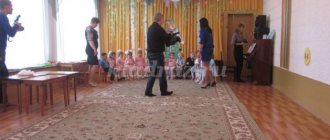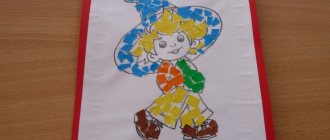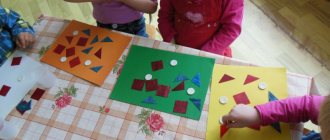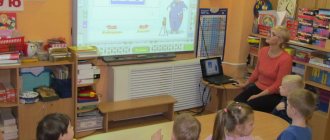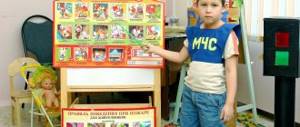Mathematics lesson in 1st junior group. Circle and square
Summary of a lesson on the formation of elementary mathematical concepts in the 1st junior group.
Topic: Geometric figures: circle and square Purpose: to consolidate ideas about geometric figures - circle and square. Objectives: Educational:
- teach to recognize, distinguish and find geometric shapes: circle and square;
- learn to correlate a geometric figure with its model; - teach children to navigate in space, use prepositions -under, -for, -7na Developmental:
- develop attention;
- develop the ability to analyze and work with didactic material Educational:
- cultivate interest in joint activities with peers;
- develop a sense of community; - cultivate a sense of empathy for the characters Speech:
- development of coherent speech - teach children to answer the question “how much?”
the word "a lot"; - use of words in speech: circle, square, round shape, square shape. Preliminary work: • Reading fiction “Zayushkina’s Hut” • D/i “Geometric Figures” • Games “Fox and Hares” • Finger gymnastics “House” Developing subject-spatial environment: Dienesh blocks (circles and squares of different sizes and colors), 2 houses, pictures with square and round objects, toys: a fox and a hare, a circle and a square made of cardboard.
Progress:
Chairs on the carpet in a semicircle.
Educator: Children, sit down on the chairs. The back was straightened, the arms were placed on the knees. There's a knock on the door. Educator: Guys, who is that knocking? I'll go open the door. (I take the hare and fox toys) That's who knocked on our door! Did you find out? Children: Yes, it's the fox and the hare. Educator: Where do you think they came to us from? Children: from the forest. Educator: Do you remember the fairy tale about the fox and the hare? Children: Yes, Zayushka’s hut. The fox kicked the bunny out of the house because her hut had melted. Educator: Correct. But now the fox and the hare have become friends, the fox promised not to offend the bunny anymore. Today they came to visit us so that the children could help them build houses. Let's help the animals? Children: Yes! Educator: Let's get down to work together and build new houses for the fox and the hare. And let them “walk” around our group. Finger gymnastics All day long knock and knock - a ringing sound is heard (hands clenched into fists, thumb raised up, tapping on the index finger) Hammers knock (knock fist on fist) We build a house for the animals. This is such a good house. How wonderful we will live! (show “roof”) Educator: These are the kind of houses we got! Where are our little animals? Let's go look for them. Are they near the closet? Children: No Teacher: Is there something under the table? Children: No! Jr. At this time, the teacher scatters Dienesh blocks in the form of a path on the floor. Educator: That's where they are! They hid behind the sofa! Dana, where are the little animals hiding? Children: Behind the sofa. (I ask 3-4 children) Educator: Fox, bunny, we built houses for you, let’s go have a look. Oh, there's a blockage on our way. How will we get to the house?! To go further, we need to clear the road. Guys, these are not ordinary stones. Look what shape they are? What geometric shapes do they resemble? Children: circle and square. Educator: Well done! Let's clear the path of stones. We will put all the round pebbles on the round “stump”, and square-shaped pebbles on the square “stump”. What shape of pebble did you take? Why did you put it here? (2-3 children) Good guys, everyone did it! Because we worked together, because together it turns out faster and better: everyone managed to arrange the pebbles into shape. Look! These are houses. But they are different. What is painted on this house? Children: circle Teacher: And in the other house? Children: square Educator: How can we now understand who gets which house? Look, the animals have badges. What shape is the fox's badge? Children: square Teacher: What about the bunny? Children: round Teacher: Well done! Now we know where whose house is. Let's plant them next to our houses. Bunny, your house is round. What should we say to the fox? “Fox, your house is square.” Let's visit each other together. And you, kids, sit down on the chairs. Guys, there is nothing in the houses of the fox and the hare. How to be? We need to help them arrange their huts. Are you ready to help? Children: Yes Educator: I have pictures, but they are not simple. Some objects on them are round, and some are square. What do you think we should put in the fox’s house? What shape? Children: square Teacher: What shape of objects should we put in the house for the bunny? Children: Round. Educator: Why? Children: Because the bunny has a round icon. I suggest going to the table and taking 1 picture. Ask the children: “What is shown in the picture? What shape? Who needs to be put in the house?” Educator: Well done. You were able to determine the shape of objects in the pictures. The animals became cheerful and happy! Because their house is no longer empty, it has many items that they need every day. They thank you for their new homes, for being able to furnish them, and invite you to play with them and celebrate their housewarming. Outdoor game “Fox and Hares”
We leave the animals in the houses, say goodbye to them
Teacher, Children: Goodbye, fox and bunny! All the best to you!
We recommend watching:
Summary of GCD in the 1st junior group on FEMP “Let's treat the Bunny with a carrot” Summary of GCD in the 1st junior group on the formation of a holistic picture of the world Summary of a design lesson in the 1st junior group Summary of a lesson with children of the first junior group
Similar articles:
Summary of GCD in the 1st junior group by February 23
Lesson notes for the early childhood group in kindergarten
Lesson summary for an early age group. Cockerel
Lesson summary for an early age group. Dandelion
Summary of a game development lesson in kindergarten in the second group of early age on the topic: Toys
Summary of mathematics lesson in 1st junior group
Program content:
1. Learn to select objects based on color, by display and by verbal designation.
2. Develop ideas about geometric shapes.
3. To consolidate children's knowledge of colors and shapes.
4. To develop the ability to isolate and combine objects according to one (common) characteristic.
5. Develop imagination, memory, imaginative thinking.
6. Cultivate curiosity, expand the experience of orientation in the environment, enriching children with a variety of sensory impressions.
Demonstration material.
Two screens: one depicts a large house, the other a small one. Two ribbons: short - red, long - green, two toy bears, geometric shapes: circles, squares (green, blue and yellow), hoops yellow, green and blue, two cars - large and small, cubes and balls : large and small (yellow, green and blue).
Progress of the lesson:
Educator. Today we will go to visit our friends, and who you will now recognize.
Clumsy, clubfooted,
When they sleep, they suck their paws,
They eat raspberries and love honey.
What are their names? (bears).
Educator. That's right, these are bears, to get to them we will need to go along a long path. (there are two tracks on the floor: a long one - green and a short one - red).
Educator Let's go along the long path, which of the two paths is longer - red or green? (Green.) I lay out the green ribbon: one end of it is near the children’s feet, the other is near the screen with pictures of houses. Children follow the teacher along the tape and approach the screen. Educator. We walked and walked and came to the houses of our friends - the bears. Look at the houses the cubs have. Are they the same? (No, one is big, the other is small). What about the bear cubs? (one big, one small)
Educator. What house do you think big Misha lives in (in a big house). And which one does little Mishka live in (in a small house).
I place the toys next to the corresponding houses.
Educator. Our friends the bear cubs are sad today, let's find out. What's happened. Guys, they need our help. Their friend Toptyshka sent them toys, here they are, but they are all mixed up and now they don’t know where whose toys are (I show the toys: 2 cars, cubes, balls of different sizes and colors). Shall we help?
I show the toys and ask:
Educator. What is this? That's right, the ball.
How big or small is it?
What color is the little ball?
Who do you think should put it in? Big bear or little one?
Educator. You guys are great, the bears thank you for your help. And for this they want to give you their toys - geometric figures. I make riddles
I have no corners
And I look like a saucer
On the plate and on the lid,
On the ring, on the wheel.
Who am I, friends? (Circle) .
I draw a circle with my hand and invite the children to draw a circle with their hand in the air.
Every angle is straight,
All four sides
Same length.
I'm glad to introduce myself to you!
What's my name? ( Square)
I trace a square with my hand and invite the children to draw a square in the air.
Educator. Do you want to play with these figures? Game "Find the house".
In the clearing there are hoops - houses, what color are they? (blue, yellow, green). And there are circles nearby, what color are they? (blue, green, yellow). You will need to find houses for the circles by color.
While the music is playing, children take circles and find houses for them.
The game with squares is played again.
Guys, did you enjoy playing? (children share their impressions). What did you do, what did you do? (we looked for houses for figures by color, selected toys by size).
Well done boys. Now it's time for us to return to kindergarten.
Summary of an open lesson on FEMP in the first junior group “Geometric Figures”
The teacher suggests tracing a circle with your finger.
Educator: Let's look further:
- I have three tops, three corners, three sides. Who am I?
Children: Triangle.
He takes out a triangle and attaches it next to the circle: “What else did the Bunny bring us? What is the name of this figure?
The teacher invites the children to repeat the name of the figure in chorus, and for some children to show its sides and angles.
Educator: Well done! And here is another figure:
“I’m not an oval, I’m not a circle, I’m not a friend to a triangle,
This is the kind of brother I am.
And my name is...
Children: Square.
Then he takes out a square, places it next to the triangle, names the figure, shows the sides and corners of the square and asks the children: “What does a square have? How many sides does a square have? How many angles does a square have?
The teacher asks the children to circle the square and show its sides (corners).
The teacher summarizes the children's answers and actions.
part 2
. Educator: “What great fellows you all are. They correctly named all the geometric shapes that Bunny brought. I think he really enjoyed being with you, and he offers to warm up a little.
Physical school
The little gray bunny sits and wiggles his ears!
(Children squat down and use their hands to imitate how a bunny moves its ears)
Just like that, like that, and he moves his ears!
It's cold for the bunny to sit, we need to warm his little paws,
That's it, that's it, we need to warm our little paws!
(Children lightly clap palm to palm, then stand up)
It's cold for the bunny to stand, the bunny needs to jump!
Hop - hop - hop - hop, the bunny needs to jump!
(Children jump on two legs, pressing their hands to their chest)
Someone scared the bunny, the bunny jumped and ran away.
(The children scatter in all directions, and the teacher takes the fox and runs after the bunnies)
Educator: - Well done! The bunny told me that in our group there are a lot of objects that have the same shape as his gifts - a circle, a square, a triangle. And he offers to find them.
Look, under each of you there is a card with a picture of a circle, square, triangle. Take them and look at them. Then look carefully at our group and find something round, square, triangular.
(Children, in accordance with the image on the card, find the necessary objects of round, square, triangular shape.)
Educator: Well done, you also coped with this task.
Part 3.
Outdoor game "Find your house."
There is a circle, a triangle and a square on the tables. Children take one geometric figure that was under their chairs and call them the keys to the house (hoop). Children with keys go to the carpet and begin to move to the music. At the end of the melody, the teacher says that it is night and they must find their houses: those with a circle in their hands run to the circle, those with a triangle run to the triangle, those with a square run to the square. When the children take their places, the teacher asks them to justify their choice.
Notes on mathematics in 1st junior group
Summary of the final lesson in the first junior group on cognitive development (FEMP) on the topic: “Funny little train”
Program content:
Consolidate knowledge of the number of objects (one-many); primary colors (red, blue, green, yellow); learn to assemble a whole from parts; ability to distinguish the size of objects (large - small). Develop fine motor skills of children's hands. Develop memory, thinking, intelligence. To foster friendly relationships between children and interest in activities.
Material:
a toy bear, chairs for children, carriages, wheels, two boxes (large and small), toys large and small.
Progress of the lesson
Educator:
Guys, we have guests today. Let's say hello to them.
Children:
Hello!
Educator:
Look who it is?
(children answer “A steam locomotive and carriages.”
Tell me how many locomotives and carriages?
( there is one locomotive, but there are many carriages).
Correct!
1. Didactic game
“One - many”
Purpose:
consolidate the ability to distinguish between the number of objects (one-many), when answering, use the words one, many.
Educator:
But you and I can’t go because our trailers don’t have wheels. Let us repair them for you.
2. Didactic game
“match by color”
Game progress:
invite the children to help the trailers find their own color. On one table there are trailers and wheels. The child needs to take one trailer, find the trailer by color (the same as the trailer), and name the color. The game continues until all the trailers have wheels.
Educator:
Well done boys.
Educator:
Now take your seats and let’s go visit the bear. Here we are. Look, the bear is sitting and crying. Let's go and ask the bear what happened.
Educator
: Children, Mishka told me in my ear that he was playing with the toys, but now he can’t put them back into the box. So that his mother does not scold him, let us help him and collect all the toys.
3. Didactic game
“Cut pictures”
Objectives: to teach how to assemble a whole from parts; develop children's thinking; To form in children ideas about the holistic image of an object, to teach them to correlate the image of the idea with the holistic image of a real object, to fold a picture cut into 4 parts. Act by applying. To cultivate in children attention, perseverance, and perseverance in completing the assigned task.
Equipment. Cut pictures from 4 parts. Items and toys that match those in the pictures.
4 .
Didactic game “more - less”
Purpose:
strengthen the ability to distinguish objects by size.
Equipment:
two boxes (large and small), toys (large and small), a toy bear.
Progress of the game.
Children need to help the bear put the toys into the box. Collect large toys in a large box, and small ones in a small one.
Educator:
Fine! Guys, the bear thanks you for your help. Look, I still have a box, the bear has prepared a sweet treat for you. It's time for us to go back to kindergarten. We take our seats and set off. - Attention attention! Next stop: Kindergarten.
Educator:
So we returned to the Kindergarten.
Tell me who we met during our journey ( children's answers
). Did you like it?
GCD for FEMP in the first junior group
Lesson on FEMP in kindergarten in the younger group
Lesson on FEMP in a preschool educational institution for younger preschoolers
Technological map of organized educational activities
Educational areas:
Cognition.
Communication Section
: FEMP
Topic:
Above - below.
Far - close Goal:
Formation of the concept of the spatial arrangement of objects (above - below in the figure and immediate proximity to oneself
Tasks:
1.EDUCATIONAL: • Reinforce concepts: concepts about the spatial arrangement of objects
2. DEVELOPMENTAL: • Form attention, thinking, imagination, memory. • Develop connected speech.
3.EDUCATIONAL: • Cultivate goodwill, a sense of mutual assistance. • Cultivate neatness.
Vocabulary work:
Up, down, far, near
Equipment, demonstration material
: toy hare, picture “Wolf” and tasks on A2., multi-colored cubes of various sizes.
1. Organizational moment “Give a smile”
(Children stand in a circle) All the children gathered in a circle. I am your friend and you are my friend. Let's hold hands tightly and smile at each other.
Surprise moment
— Guys, do you like fairy tales? Let's remember fairy tales about animals? (Knock on the door) I'll go see who's knocking on our door. (The teacher brings in a little bunny) - Oh, guys, look who came to us. Yes, he's shaking all over, let's ask why? The little hare asks us to help cover him. Someone is chasing him. Let's help him hide. And we will find out who is chasing him ourselves. And now I’ll show you how. (On the board there is a drawing of a Wolf covered with tasks) To find out who is chasing our bunny, you need to open this drawing.
1. Task
Name geometric shapes 2. Task (“Top-bottom, left-right”) Look at the picture. Tell us who is where? (Answer: The boy is above and the girl is below. The boy is on the left and the girl is on the right)
Fizminutka
I will blow high (raise my arms up) I will blow low (put my hands down) I will blow far (extend my arms in front of me) I will blow close (put my hands on my chest) (blow).
3. Task. Game-task.
“Find such a cube” among other cubes identical in size but different in color.
Individual work
Lera, what do you see in the picture? (Answer: a boy and a girl) Where is the boy? (Answer: far) Artem, what do you see in the picture? (Answer: a boy and a girl) Where is the girl? (Answer: close)
3.Task Work in a notebook. "Help the hedgehog"
- Guys, if we help the hedgehog, we will find out who scared our bunny after all.
Reflective-corrective stage: the teacher creates a situation of success for all children. He thanks him for participating in the lesson, says that the children pleased him with their actions, answers and desire to help the bunny (notes especially diligent children). Addresses the children with the question: “What was interesting for you in class today, what did you remember, what would you tell your mother about, etc.” For your kind hearts, for your efforts, for your desire to help and not leave you in trouble - accept a surprise from the bunny. (children receive stickers with images of bunnies)
Summary of a lesson on FEMP in the first junior group of a preschool educational institution
Lesson on FEMP in the first junior group “Magic journey on a train”
Purpose of the lesson. Improve the ability to compare objects by width (wide-narrow) and indicate the results of comparison with appropriate words; exercise knowledge of geometric shapes (circle, square, triangle) and the ability to find them in the environment; improve the ability to single out one item from a group; develop thinking: learn to see patterns in the arrangement of objects and reproduce them; foster interest in mathematics and children's independence. Didactic visual material. Butterflies - yellow, red, blue, green;
paper flowers of the same colors (according to the number of children); 2 streams of paper (wide and narrow); tickets with images of geometric shapes (triangle, square, circle) of different colors; jars of water, brushes, paints of three colors (red, blue, green); plate with sweets. Progress of the lesson:
Children stand in a circle. Educator: Guys, let's hold hands and smile at each other. - Good morning! It’s a wonderful morning today because you and I are in it! Guys, today we will go on a trip. What do you think you can travel on? (Children's answers) Guess the riddle and find out what you and I will travel on. I’m riding in it on the top shelf To the sea, to the sun to the south, And the wheels are incessantly Knock-knock-knock! Knock-Knock! (Train) That's right! this is a train and we will also go on a magical journey on a train. But to do this you need to get tickets to take your place. Look carefully at your tickets. What is depicted on them Children's answers (geometric shapes of different colors). You need to sit in the place that shows the same figure as on the ticket. (Checking seats and tickets). - Well, now let's go! The locomotive hummed and the trailer drove Chu-chu-chu, chu-chu-chu! I'll take you far! Green carriages Run, run, run And round wheels Knock-knock, knock-knock, knock-knock! (Music "Little Engine Song") Educator: Guys, let's make a stop, but first I'll ask a riddle. 1. They smell fragrant, but not perfume 2. They give it to mothers on holiday (Flowers) Look at what a beautiful flower meadow is ahead. (They go out) There are two streams on the floor, a wide one and a narrow one. - Oh, streams blocked our path. How many are there? Are they the same? Which stream is easier to step over? (Children's answers) Let's step over the narrow stream. - Look, flowers grow here. How many or few are there? Are they the same color? What color are the flowers? (Children's answers) Educator: Listen to the riddle All four petals of the flower moved. I wanted to pick it, He wanted to pick it, He took off and flew away. (Butterfly) - Look, butterflies are sitting there. How many are there? (Children’s answers (Many) Educator: Let’s play the game: “Find a flower for each butterfly.” Children must find a flower for the butterfly of the same color as the butterfly. (Children’s game) Let us also turn into butterflies and fly. Slept flower and suddenly woke up. Didn't want to sleep anymore. Stretched, moved, soared up and flew. And now you and I will go to the kingdom of color. Look at the jars of water here, how many are there? What's there? What kind of water? (Children's answers) Let's take the brushes and paints and color the water. What happened? (Children's answers) Now we are going to go to kindergarten. (The teacher has a plate of candies in his hands.) Educator: How many candies are in the plate? What color are they? (Children's answers). The girls take candies are red, boys are blue. How many are left? (Children's answers (one). The teacher takes the last one. How many are left? (not one) Did you like the trip? (Children's answers).
We recommend watching:
GCD summary for children of the 1st junior group on cognitive development (mathematics) GCD summary for the formation of elementary mathematical concepts. Second junior group Notes of GCD in mathematics for the junior group of kindergarten. Counting within 6 Summary of a lesson on mathematical development in the second junior group for gifted children
Similar articles:
Math lesson notes. Topic: "Circle". Second junior group
Scenario for mathematical entertainment in the younger group
Summary of a mathematical game in the second junior group
Summary of the game in mathematics in the 2nd junior group
